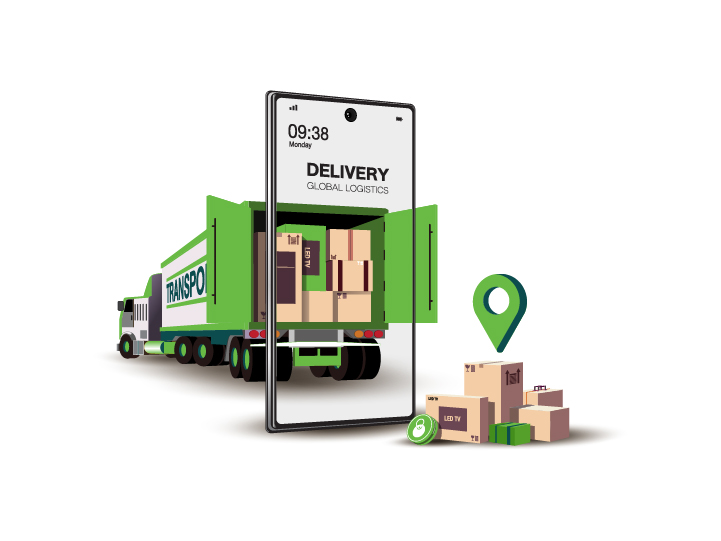The Pros and Cons of Dropshipping in E-commerce Inventory Strategies
In recent years, dropshipping has emerged as a revolutionary business model, transforming the landscape of e-commerce. This innovative approach offers entrepreneurs and businesses unparalleled flexibility, minimal upfront investment, and the potential for significant profits. The number of people searching the term “dropshipping” has increased exponentially from 2020 through 2023. That's why understanding the dynamics of dropshipping is essential for anyone looking to delve into the world of online commerce. In this blog, we will explore the fundamentals of dropshipping in e-commerce, and how it operates both within marketplaces and webstores.

Dive into the dynamic world of dropshipping success with Ginesys
How Popular is Dropshipping?
Unlike traditional online retail, dropshipping does not require traditional fulfillment methods to sell products. That means, as a product company you outsource all aspects of the supply chain, including assembly of your products, storing inventory, and working with carriers to get products to customers.
Dropshipping is one of the easiest, low-barrier businesses to enter provided you have access to the internet. Dropshipping remains a lucrative business model, offering dropshippers the advantage of potentially earning over 50% more profit compared to those managing their inventory. Additionally, suppliers can benefit from an 18% increase in profit by supplying products to dropshippers.
The growth and popularity of dropshipping in the ecommerce industry have been remarkable. According to recent statistics, the global dropshipping market size is projected to reach unprecedented heights, fueled by advancements in technology, changing consumer behaviors, and the allure of entrepreneurship. The dropshipping market size has been projected to reach $476 billion in the next 4 years. In fact, the global dropshipping market size was valued at $225.99 billion in 2022 and will hit a compound annual growth rate (CAGR) of 23.5% from 2023 to 2030.

Dropshipping: Ginesys transforming retail with minimal investment and maximum returns.
How Does Dropshipping Work in Marketplaces?
- Product Listing Without Inventory: Merchants list products on the marketplace without holding any physical inventory.
- Order Placement: When a customer places an order and completes the payment, the marketplace receives the order details.
- Direct Shipping: The marketplace then forwards the order information to the supplier, who ships the product directly to the customer. Alternatively, the marketplace may receive the goods from the supplier and then reship them to the shopper.
- Profit Generation: Profits are generated from the price difference between the supplier's cost and the customer's payment.
How Does Dropshipping Work for Webstores?
- Product Listing Without Inventory: Products are listed on the webstore without the merchant holding any inventory.
- Order Fulfillment: When a customer places an order, the merchant receives the order details.
- Shipping Process: The merchant then arranges for the product to be shipped directly from the supplier to the customer. Alternatively, the merchant may receive the goods from the supplier and then reship them to the shopper.
- Profit Mechanism: Profits are derived from the price markup on the selling price, allowing the merchant to capture the difference between the wholesale cost and the retail price.

Advantages of Dropshipping:
- Smaller Startup Costs- Dropshipping eliminates the need for purchasing and managing inventory upfront, significantly reducing initial investment costs for entrepreneurs. Since the dropshipping model is based on acting as a middleman between the customer and supplier, a dropshipper never actually holds any inventory. With that in mind, dropshipper significantly saves on startup costs. Additionally, the cost of opening a dropshipping business on eCommerce platforms like Shopify or Wix is quite affordable and can be quickly recovered.
- Testability- Traditionally, introducing new products to the market is challenging because of investment in the stock upfront. With dropshipping, you can swap products in and out of your store at will. This makes it easier to test new products in your target market. Merchants can quickly and easily test new products and product variances. This will allow them to optimize their marketing efforts to the best-performing product.
- Flexibility- It allows small businesses and entrepreneurs flexibility with their hours. They can virtually operate their business from anywhere in the world and can essentially sell any product. Without the need for a warehouse or return address, you only run the customer-facing end of your business from anywhere. Your focus lies in effectively communicating with your customers and suppliers.
- Low-risk business model- Dropshipping serves as a safeguard for merchants, preventing excessive spending. What distinguishes this model as exceptionally low-risk is its payment structure as they operate on a per-order basis. Additionally, the burden of shipping logistics is lifted off their shoulders, as the suppliers handle that aspect. With minimal startup costs and virtually no risk exposure, dropshipping emerges as the ultimate solution.
- Scalability- By relinquishing the burden of inventory management and shipping logistics, dropshippers can unlock the ability to cater to a global market. Alternatively, they can seamlessly explore local suppliers within the target markets they aim to penetrate. Consequently, as their product range can be big, this allows them to sell more and scale faster.

Transforming dreams into global ventures, dropshipping scales effortlessly with Ginesys.
Challenges of Dropshipping:
- Order Processing Complexity: Coordinating orders between multiple suppliers can lead to logistical challenges, including delayed shipments, and order inaccuracies, requiring efficient management systems. As the customer’s point of contact, it is left to you to explain what went wrong and how you’ll fix it. The quality and accuracy of the order fulfillment process may suffer as fulfillment is likely not the strength or focus of the manufacturer.
- Limited Product Information: Retailers may face limitations in accessing detailed product information and quality control measures, potentially affecting customer satisfaction and brand reputation. As the middleman, they know as much about product quality as their customers. So, if a product turns out to be of poor quality, they pay the price, not the supplier.
- Customer Service Challenges: Handling customer inquiries, returns, and complaints becomes more challenging, as retailers may have limited control over product quality and shipping processes. Offering excellent customer service is important to gain credibility and increase customer loyalty. Ultimately, this can only help dropshippers to stand out from the competition.
- Intense Competition: The popularity of dropshipping in e-commerce has led to a saturated market with intense competition, requiring retailers to differentiate through branding, marketing, and customer experience to stand out amidst competitors. Additionally, the high competition can bring the profit margins down.

Navigating challenges dropshipping effortlessly with Ginesys.
The Right Approaches to Dropshipping
- Market research: Businesses can use dropshipping to mitigate the risk of trying out new products and do the required market research. Rather than raising the inventory costs by packing the warehouse with an unpredictable product, test it out with a trial period using dropshipping. This becomes more important for trying out new products, which always carry inherent risks.
- Protection from overselling: Experienced e-commerce brands know that market fluctuations aren’t always predictable. Rather than raising inventory costs by overstocking to meet unlikely maximums, having a dropshipping supplier saves money without losing those sales. This is especially useful for seasonal overflow. Having dropshipping options in place also makes great insurance against extreme circumstances.
- Strategic shipping systems: One unfortunate consequence of expanding your business is shipping complications. Dropshipping can be the perfect solution for some problematic locations that fall outside your profitable regions. Utilizing dropshipping strategically in specific areas could prove instrumental in maintaining profitability. Furthermore, beyond its role in market research, dropshipping serves as a valuable tool for testing new markets and geographical locations.
- High-maintenance products: Any products that necessitate extra fees for storing or shipping, such as products that take up too much space, products that weigh increasing the shipping cost, fragile products requiring special care when shipping, high-value items requiring additional security that not all warehouses can offer. Unless the entire company specializes in these types of products, it doesn’t make sense to pay additional storage and shipping fees for a small subsection of your business.

Dropshipping: Crafting Success Through Strategic Flexibility and Cost Efficiency.
Software for Successful Dropshipping
Dropshipping has revolutionized the retail landscape, offering entrepreneurs the opportunity to run businesses with minimal upfront investment and inventory management. However, the success of a dropshipping venture hinges on efficient software solutions tailored to its unique demands.
- Role of OMS: Central to the seamless operation of a dropshipping business is an Order Management System (OMS). This software facilitates order processing, tracking, and communication between retailers, suppliers, and customers. By consolidating order information and streamlining workflows, an OMS significantly reduces errors and delays, ensuring timely delivery and customer satisfaction.
- Automating PO to supplier: Automating purchase orders (PO) to suppliers are essential for maintaining optimal inventory levels and meeting customer demand. Automated systems accurately forecast demand based on sales data, triggering POs to suppliers as inventory levels fluctuate. This improves efficiency and minimizes the risk of stockouts or overstock situations, enhancing profitability.
- ERP integration: ERP software consolidates various business functions such as inventory management, order processing, accounting, and customer relationship management into a single platform. This integration provides retailers with real-time insights into their operations, streamlining processes, optimizing inventory levels, and enhancing decision-making capabilities.

Paving the Roadmap to Success in Dropshipping with Ginesys
In the realm of dropshipping, success hinges on efficient operations, seamless management, and robust systems. With Ginesys Order Management System (aka Browntape) and Ginesys Enterprise Resource Planning solutions, businesses can elevate their dropshipping endeavors to new heights of efficiency and profitability. Whether you prefer internal fulfillment, dropshipping, or a blend of both, Ginesys empowers you to explore various models effortlessly. Alternatively, you can opt for full automation, allowing Ginesys One to seamlessly handle every aspect of your fulfillment process.
Ginesys OMS and ERP for Success in Dropshipping:
Streamlined Operations: Ginesys OMS (Browntape) and ERP streamline the entire order fulfillment process, from order placement to delivery. With this integration, businesses can eliminate bottlenecks and fulfill orders with unparalleled efficiency.
Real-time Data Insights: Ginesys provides comprehensive analytics and reporting capabilities, empowering businesses to make data-driven decisions, optimize inventory levels, and anticipate customer demand.
Seamless Integration: Ginesys OMS seamlessly integrates with various e-commerce platforms, marketplaces, and third-party logistics providers, ensuring a smooth flow of information across the entire supply chain.
Scalability and Flexibility: As dropshipping businesses grow, they need scalable solutions that can adapt to evolving needs. Ginesys OMS and ERP are designed to scale effortlessly, accommodating increased order volumes, expanding product catalogs, and diversifying sales channels without compromising performance.

Effortless Efficiency: Ginesys OMS and ERP redefine dropshipping success
Although dropshipping is a great way to test a new product and start a profitable business, it has limitations. As the marketplace gets saturated with competitors, dropshippers will likely be forced to compete on price. Consequently, transitioning to a partnership with a full-fledged tech suite such as Ginesys One emerges as the right move. Ginesys OMS and ERP solutions are indispensable tools for success in dropshipping, offering streamlined operations, real-time data insights, seamless integration, and scalability. By harnessing the power of Ginesys One, businesses can navigate the complexities of dropshipping with confidence.

